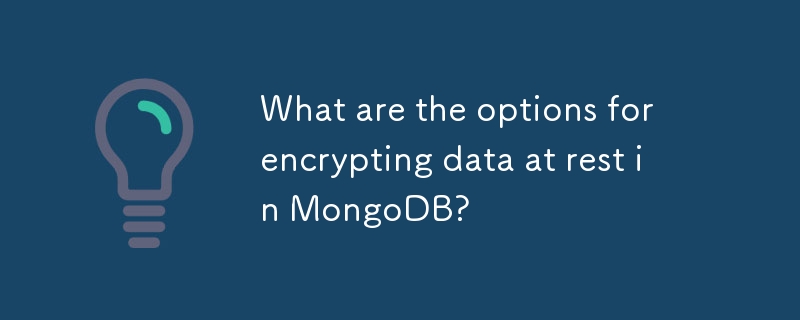Found a total of 10000 related content

CentOS: A Community-Driven Linux Distribution
Article Introduction:CentOS is a stable, enterprise-grade Linux distribution suitable for server and enterprise environments. 1) It is based on RedHatEnterpriseLinux and provides a free, open source and compatible operating system. 2) CentOS uses the Yum package management system to simplify software installation and updates. 3) Support advanced automation management, such as using Ansible. 4) Common errors include package dependency and service startup issues, which can be solved through log files. 5) Performance optimization suggestions include the use of lightweight software, regular cleaning of the system and optimization of kernel parameters.
2025-04-17
comment 0
796

Evaluating Ubuntu Server and Oracle Linux: Which Operating System Excels in Database Management?
Article Introduction:Enterprise-level database operating system: In-depth comparison between Ubuntu Server and Oracle Linux
In the enterprise computing world, choosing the right database management operating system (OS) is critical because it is directly related to performance, security, and scalability. Ubuntu Server and Oracle Linux are among the best, each with its own advantages to meet different enterprise needs. This article compares these two operating systems, focusing on their functionality, performance, and applicability to database workloads.
Ubuntu Server Overview
Ubuntu Server is a free and open source Linux distribution developed by Canonical Ltd.
2025-03-07
comment 0
1012

Article Introduction:This article guides you on how to install, configure and use the GitLab plug-in on your Debian system to improve code management and collaboration efficiency. GitLab is a powerful open source code hosting platform for teams and individual developers. 1. GitLab installation and update system package: sudoapt-getupdate installation dependency: sudoapt-getinstall-ycurlopenssh-serverca-certificatestzdataperl Add GitLab official source: curlhttps://packages.gitlab.com/in
2025-04-13
comment 0
1061

10 Lightweight and Easy to Use Open-Source CMS
Article Introduction:Ten lightweight content management systems (CMS) recommendations, say goodbye to bloat and embrace simplicity!
Not all website projects require a highly functional content management system. Sometimes, a lightweight, simple system is the best choice. We have carefully selected ten lightweight CMSs (not file size, but system complexity) to help you and your customers manage content easily! Of course, this article won't mention WordPress, although I think it's the best free open source CMS right now.
Zimplit CMS
Extremely lightweight, simple, customizable and open source. Easy to install and use, its simple web interface contains only one core engine file.
CMS from Scratch
Fast, simple and open source to make web pages
2025-03-02
comment 0
504

What is mysql used for? Explain the main application scenarios of mysql database in detail
Article Introduction:MySQL is an open source relational database management system, mainly used to store, organize and retrieve data. Its main application scenarios include: 1. Web applications, such as blog systems, CMS and e-commerce platforms; 2. Data analysis and report generation; 3. Enterprise-level applications, such as CRM and ERP systems; 4. Embedded systems and Internet of Things devices.
2025-05-24
comment 0
1266

Whose mongodb database is
Article Introduction:MongoDB database was created by 10gen, a company founded in 2007 and specializes in providing open source database solutions. MongoDB was originally an internal database for its Content Management System (CMS) developed by 10gen, and later released as a standalone product in 2009. 10gen was reorganized into MongoDB and MongoDB Atlas in 2018, which are focused on the development and hosting cloud services of MongoDB databases respectively. MongoDB offers two licensing options: a free and open source community version and a business-friendly enterprise version.
2025-04-12
comment 0
858

Redis configuration steps on CentOS
Article Introduction:Installation and Configuration Guide for Redis under CentOS System This guide details how to install and configure the Redis database on CentOS system. Step 1: Install the dependencies First, make sure that the system has the necessary compilation tools installed. Open the terminal and execute the following command: sudoyumininstall-ygccmake Step 2: Download the Redis source code Download the latest version of the source code package from the Redis official website. For example, download Redis6.2.6 version: wgethttp://download.redis.io/releases/redis-6.2.6.tar.gz``` (Please replace it with the latest version chain
2025-04-14
comment 0
743

Developing a Static Site Generator Workflow
Article Introduction:Static website generator: a tool to improve the workflow of landing pages
Core points:
Static website generators such as Hugo offer many advantages including full control over content and web design, speed improvements and flexibility enhancements. Unlike content management systems such as WordPress builds pages every time a visitor requests, the static website generator builds web pages when creating or editing new content.
Migrating to a static website generator can simplify hosting. Usersnap successfully uses Netlify, which works well with GitHub and provides a simple deployment process.
Use GitHub for source code management, use Codeship for automated testing, and use Usersnap for manual testing.
2025-02-19
comment 0
512

Maximizing Your Content Management System with Linux
Article Introduction:Introduction In the evolving field of web development and management, choosing the right operating system (OS) to host your content management system (CMS) can significantly impact the performance, security, and cost-effectiveness of your website. With its open source features and powerful capabilities, Linux has become the first choice for developers and administrators around the world. This article explores the many benefits of using Linux to manage popular CMS platforms such as WordPress and Drupal, focusing on why it becomes the best solution for modern network infrastructure.
Cost-Effective One of the most compelling reasons to choose Linux is its cost-effectiveness. Unlike proprietary operating systems that require expensive licenses, Linux is open source and available for free. Exemption of license fee
2025-03-07
comment 0
1066

How to create an Alipay business account?
Article Introduction:The key to opening an Alipay corporate account is to prepare your company qualifications and follow the procedures. 1. You need to prepare a business license, scanned copy of the legal person ID card, corporate account information and handling information, and the documents must be clear and complete; 2. Enter the merchant center through the Alipay official website, select enterprise certification, and directly upgrade it with an existing personal account; 3. Fill in the enterprise and legal person information, select the correct business category and submit the review, which usually takes 1 to 3 working days; 4. After the review is passed, you can open the payment code, payment interface, reconciliation function and sub-account management functions as needed, and gradually set it up to be more conducive to management.
2025-07-10
comment 0
136

How to implement hot reload in Debian
Article Introduction:Experience the convenience of Flutter hot reloading on the Debian system, just follow the steps below: Install FlutterSDK: First, you need to install FlutterSDK on the Debian system. Visit Flutter official website to download the latest stable version of SDK and decompress to the specified directory (for example, ~/flutter). After that, add Flutter's bin directory to the system PATH environment variable. Edit the ~/.bashrc or ~/.profile file, add the following code: exportPATH="$PATH:~/flutter/bin" Save the file and execute source~/.bas
2025-04-02
comment 0
621

WordPress website building full set of textbooks
Article Introduction:Building a WordPress website is not as difficult as climbing the sky, because it is a powerful content management system (CMS) that allows you to easily build dynamic websites. To use WordPress, you need to prepare your domain name, server, and WordPress installation package. After installing WordPress, the focus is on choosing themes and plugins that are compatible and suitable for the website type. Content is at the heart of a website, and it is crucial to regularly maintain and update WordPress. Understand the basics of databases and follow the PHP code examples provided in this article to help you connect to the database. WordPress website building requires continuous learning and practice, I wish you a smooth website building.
2025-04-20
comment 0
615

How to Deploy and Host a Joomla Website on Alibaba Cloud ECS
Article Introduction:Key points:
Joomla! is a popular open source content management system (CMS) that can be hosted on Alibaba Cloud Elastic Computing Service (ECS) with Ubuntu 16.04 installed. This CMS provides multilingual support and other features.
The process of deploying a Joomla! website on Alibaba Cloud ECS includes: setting up an Alibaba Cloud ECS Linux server, installing a LAMP (Linux, Apache, MySQL, PHP) stack, configuring Joomla! on ECS, and creating a MySQL database and user for Joomla!.
For production purposes, it is recommended to use Alibaba Cloud ApsaraDB
2025-02-15
comment 0
858

Python development_python installation
Article Introduction:Python can run on a variety of platforms, including our common ones: Windows, Unix, Linux, and Macintosh. This article will introduce in detail the process of installing Python in Windows operating system. My operating system is Windows 7, 32-bit version. When installing Python, we can choose to install it from the source code or select the already compiled binary version for installation. I chose the latter here. Step 1 Download the installation package. We download the installation package of Python from the official Python website: http://www.python.org. The version I selected is: python-3.3.2.msi click to download, I
2025-05-07
comment 0
524

phpmaster | Localizing PHP Applications Part 1: Oct 2011 - Sitepoint
Article Introduction:Internationalize your PHP application: Easily implement multilingual support using gettext
The global Internet users continue to grow, and many users want to browse your content in their native language. You may think that only an excellent translation is needed to complete the user interface translation of a website, but the bigger challenge lies in writing background code. The traditional software localization process is cumbersome and error-prone, resulting in confusion in code. Some developers even use different versions of code for different regions, which makes codebase management nearly impossible.
gettext is an excellent open source tool that simplifies the process and allows you to focus on code writing, while the translator is responsible for handling individually translated files in the target language. Master PHP gettext, expanding the global influence of applications will become
2025-03-02
comment 0
609

MySQL's Place: Databases and Programming
Article Introduction:MySQL's position in databases and programming is very important. It is an open source relational database management system that is widely used in various application scenarios. 1) MySQL provides efficient data storage, organization and retrieval functions, supporting Web, mobile and enterprise-level systems. 2) It uses a client-server architecture, supports multiple storage engines and index optimization. 3) Basic usages include creating tables and inserting data, and advanced usages involve multi-table JOINs and complex queries. 4) Frequently asked questions such as SQL syntax errors and performance issues can be debugged through the EXPLAIN command and slow query log. 5) Performance optimization methods include rational use of indexes, optimized query and use of caches. Best practices include using transactions and PreparedStatemen
2025-04-13
comment 0
837

What are the options for encrypting data at rest in MongoDB?
Article Introduction:There are four main ways for MongoDB to encrypt data at rest. 1. Encryption is implemented by configuring encryption settings and key management, which is suitable for enterprise versions or Atlas; 2. Use file system or volume encryption such as LUKS and BitLocker, which is suitable for all versions but has a coarse protection granularity; 3. Application-level encryption, encrypting sensitive fields in the code, which is highly secure but has an increased development cost; 4. MongoDBAtlas provides default underlying volume encryption, and supports custom master keys and client field-level encryption. Different solutions can be used in combination according to the deployment environment and security requirements.
2025-06-09
comment 0
371

What is the role of Debian Apache logs on website security
Article Introduction:The Apache log under the Debian system is crucial to website security, and its role is reflected in the following aspects: 1. Security event tracking and prevention Apache log records all website access requests, including information such as IP address, access time, request resource (URL) and HTTP status code. By analyzing these logs, you can: identify malicious activity: find suspicious access patterns, such as a short period of time large requests, frequent login failure attempts (brute force), SQL injection, or cross-site scripting attacks (XSS). Tracking the source of the attack: locate the attacker's IP address to provide a basis for taking defensive measures. Analyze attack patterns: Study historical log data, identify common attack patterns and trends,
2025-04-12
comment 0
463
















